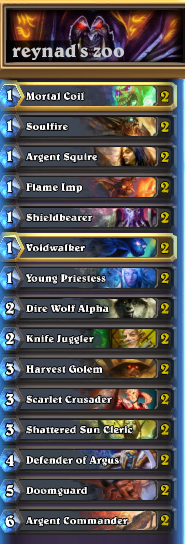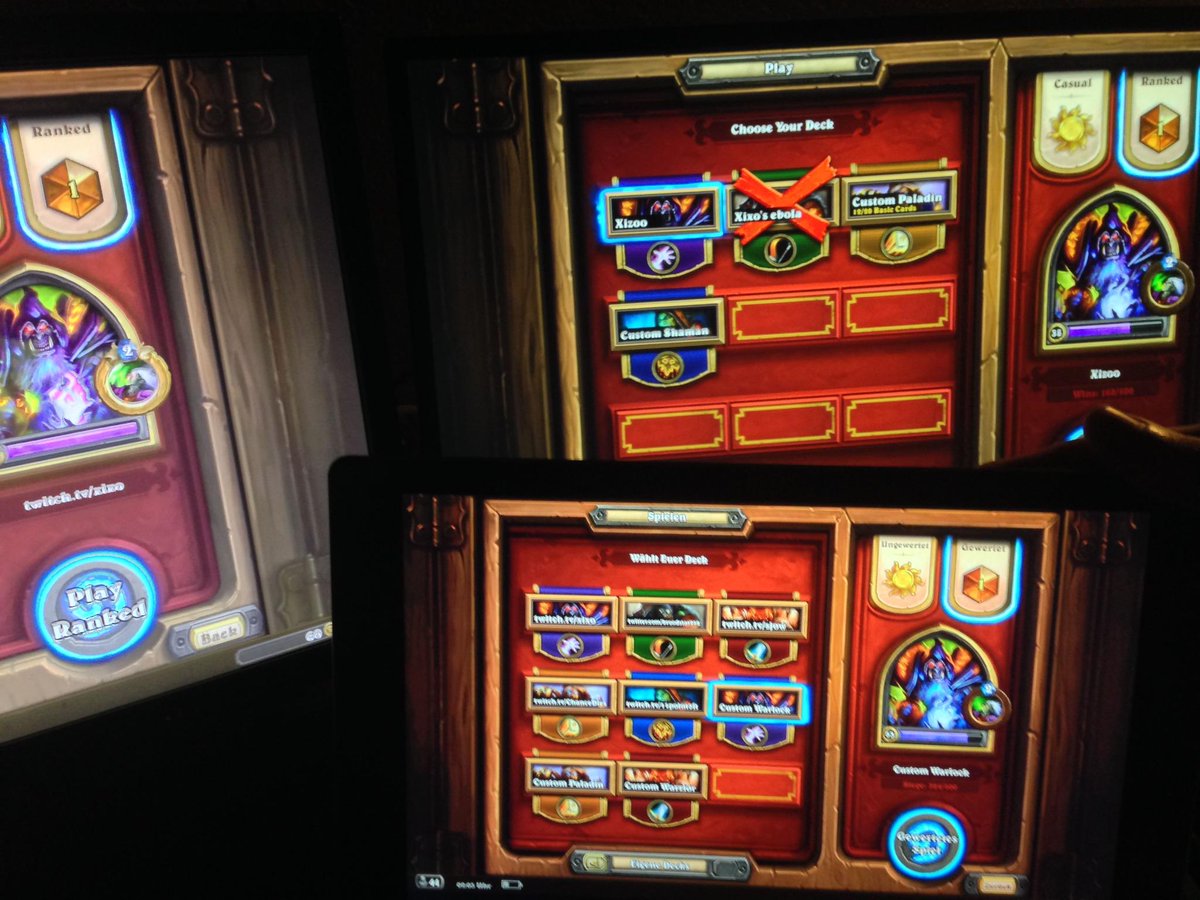The Origins of Zoo
Zoo is a deck that’s been around for a while. While it is generally acknowledged as originating as Curi’s Board Control Warlock, the deck has metamorphosised several times since. Reynad is widely credited for the addition of Doomguards to the list, though there have been accounts of their appearance first being seen on the Asian server. Oh well, at least he came up with the name.
Through these changes, though, Zoo had genuinely maintained a few key characteristics: a ruthlessly curved, board control orientated aggro deck designed to abuse the Warlock’s hero power. The idea that zoo was “board control”, and not aggro, became something of a buzz-phrase though Zoo’s earlier iterations in the Reynad era. I’d argue that while this term was accurate to an extent, it was somewhat overstressed to the extent that it led to some misunderstanding of Zoo’s true nature.

Board Control or Aggro?
Now, the aggro/control debate is a tedious one and I won’t dwell on it for too long, but my rule of thumb has always been to define decks by when they want to trade and when they want to be aggressive.
Face Hunter is widely considered the most aggressive deck in the game, but, even in this extreme, you are still generally trying to make good trades in the first 2 or 3 turns of the game before going exclusively for face. The reason for this is actually fairly simple: if you maximise your board by choosing to trade rather than going for face, your minions are likely to attack multiple times, resulting in more damage. This is why even the most degenerate aggro decks trade to some extent - it’s simply more efficient.
By this metric, the more aggressive decks are the ones that quickly transition out of this early “trading phase” into their, for want of a better term, “killing them phase”. Face Hunter does this very early, generally taking trades in the first 3 turns but not much at all after that. Granted, Zoo was never in this territory, but you still generally went for all in plays quite a bit sooner than your midrange counterparts. Reynad-era Zoo traded almost exclusively until it became convenient to dump your entire hand and play Doomguard. Around this time - when Doomguard hit the field - Zoo would try to close out the game within a few turns, using taunts to slow the opponent down while lethal damage was applied.
This game plan of pushing for the win some time between turns 5 and 8 puts this version of Zoo firmly in the aggro category. While, yes, the hero power grants some ability to keep pace with midrange decks, it could never completely compensate for the lowness of the curve. The plan was always to win quickly.
Peak and Fall from Prominence:
Somewhat unsurprisingly, the card that really tipped Zoo over the edge was Undertaker. Towards the end of last year, the best Zoo players were absolutely dominating the ladder. Chance famously finished rank 1 NA in the November season in hugely commanding fashion, retaking the top spot several times throughout the season.
After a brief lull following the release of Goblins vs Gnomes (and, with it, the nerf to Soulfire), Zoo soon rose to the forefront once again with Xixo’s insane achievement of reaching rank 1 legend on NA, EU and Asia simultaneously, a feat that may well never be matched. Imp-losion played a huge role in this version, but Undertaker was still at the core of the deck.

It was unsurprising, then, that the Undertaker nerf hit Zoo hard. Many thought Hunter would be the deck affected worst by this change, but, in the end, Hunter still had the ridiculously broken Mad Scientist to rely on, as well as the evasive potential of Worgen Infiltrator + Glaivezooka in face decks.
Zoo’s niche was always in dominating the early game exchanges in every matchup. Mech Mage, it was decided, did this far better; consequently, Zoo fell from prominence.
Modern Zoo
With the release of BRM, however, something changed. Following the release of Imp Gang Boss to the game, Zoo went through a series of changes that has led to it transitioning away from its roots as an aggro deck, to something far closer to midrange.
The first, and most traditional, list to arise was Xixo’s double Sea Giant version. Here, the Imp Gang Boss functioned as essentially a better version of Harvest Golem, with the tokens generated facilitating ludicrously cheap Sea Giants to close out the game.

Later that season, we saw Savjz take rank 1 EU with a dramatically different take on the deck. Savjz’ eschewed Argent Squires, cut Dire Wolf Alpha, and even went down to only one Flame Imp. He also added some much heavier threats like Sylvanas and the recently buffed Bane of Doom (which now summoned a truly random demon, rather than one of an extremely limited selection). The addition of Imp Gang Boss, it turns out, had turned Voidcaller into a much more potent threat. Having one more extremely solid demon for it to spit out lowered the risk of a targetless Voidcaller, and upped the average value of the Voidcaller deathrattle in a similar manner to the Bane of Doom change.

For me the most interesting development here is the inclusion of double Void Terror. The card, which had previously been considered too inconsistent for inclusion, has since enjoyed widespread adoption. Firebat put forward a great case for this card on a recent stream, arguing that with Nerubian Egg, Power Overwhelming and Voidcaller, the potential for synergy with Void Terror is so large it has a multiplicative effect. These effects frequently combine devastatingly, outright winning games in the early turns.
In the months since, the heavier Zoo list has emerged as the dominant version. Tiddler Celestial further demonstrated the potency of the archetype with his Dreamhack Summer win, using a list with many similarities to that of Savjz to fight through the 128 man open.

Better than Ever?
The current midrange build of Zoo has a lot of advantages over its predecessors. An abundance of sticky minions has strengthened the matchups vs Control Warrior, Oil Rogue, and Handlock which previously had a much easier time clearing the Zoo’s board with their AoE options. The “board control” description of Zoo is now more true than ever, with a lot of games won through the creation of a board that AoE simply cannot answer.
As a whole, Zoo is now much harder for more reactive decks to interact with. A turn 2 Nerubian Egg simply has no answer outside of Ironbeak Owl, and the Void Terror followup often just wins games. Voidcaller creates a similar problem, as opponents frequently choose to pussy-foot around it in fear of Mal’ganis or a Doomguard losing them the game on the spot.
The addition of Voidcaller means Zoo is no longer constrained by the game plan of flooding the board before playing Doomguard, as more often than not that card is now cheated into play for free, with the drawback entirely avoided. As a result the deck can be now played in a much more greedy manner, drawing more cards and frequently going toe-to-toe with control decks for long periods before crushing them with tempo.
Here to Stay
I hope this write-up has been accurate, as the development of Zoo as an archetype has been far from linear. One thing’s for sure, though - Zoo won’t be going away anytime soon.
And, yes, as Trump said, we will all be going to the zoo tomorrow.
...and tomorrow...
...and the day after that...




